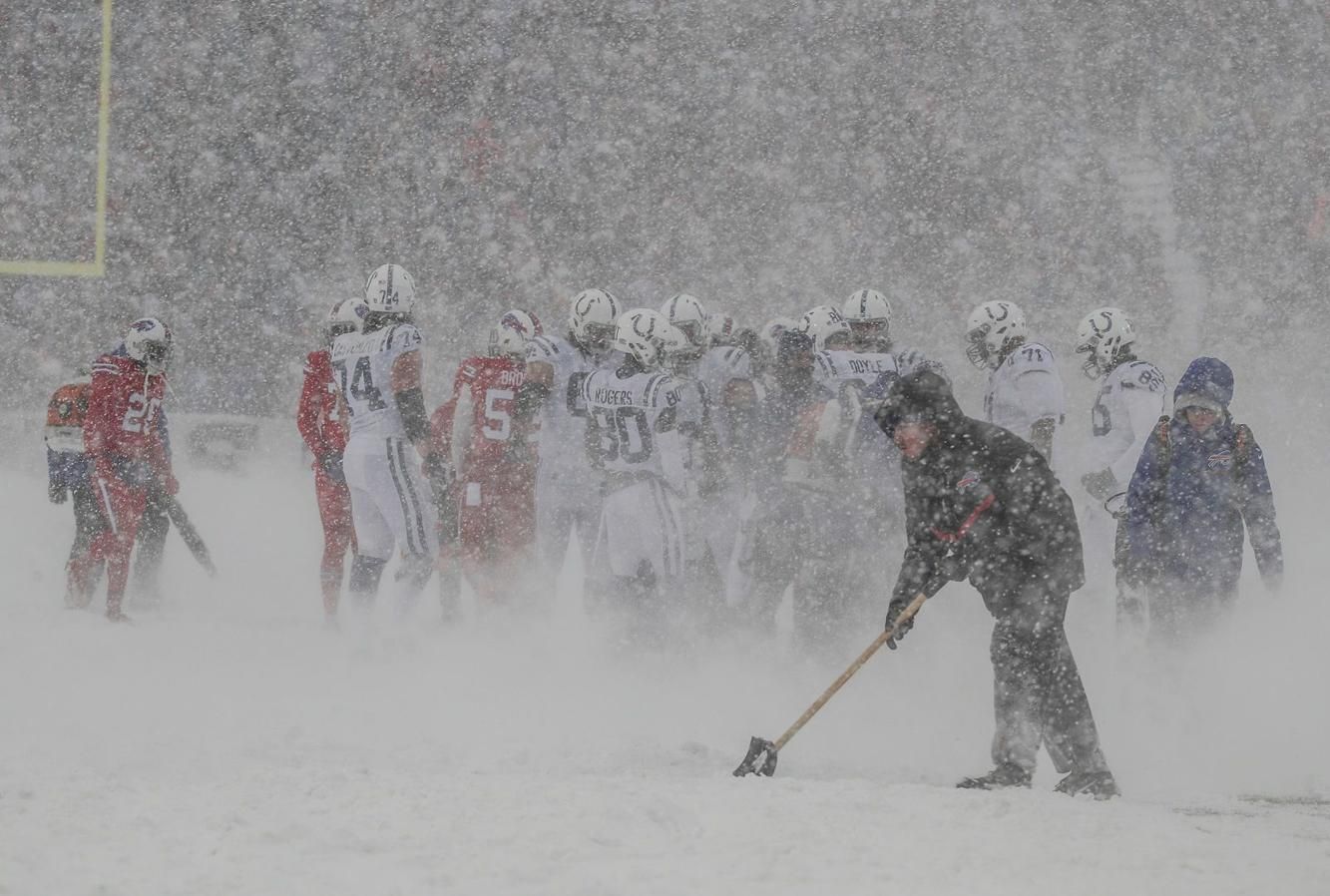Why not a dome? Buffalo's blizzardlike branding plays a role in Bills stadium plans
)
“You’re soft,” Allen said to Smith. “You got used to that dome.”
“Damn right,” Smith said, referring to the retractable roof on Atlanta’s Mercedes-Benz Stadium. “Don’t act like you don’t want one.”
The microphones that captured this exchange didn’t catch Allen’s response – if he even had one – but this much is certain: Allen won’t play a home game in a domed stadium for as long as he wears a Bills uniform.
The National Football League franchise continues to negotiate with the State of New York and Erie County to help finance the construction of a new $1.4 billion stadium across the street from its current venue in Orchard Park, but a dome isn’t part of the discussions and was never on the Bills’ wish list. An internal study conducted four years ago by Pegula Sports and Entertainment, which oversees the holdings of team owners Terry and Kim Pegula, put it bluntly: “No roof. Outdoor football.”
The reasons are connected by a single thread – money – but not just because a roof would add about $300 million to the construction costs, according to the engineering firm AECOM, which produced a report commissioned by the state.
When a team is planning a new stadium, the NFL defers to the club’s ownership on whether to pursue a dome.
“That’s a purely local decision,” Art Rooney II, co-owner and president of the Pittsburgh Steelers and a member of the league’s stadium committee, told The Buffalo News this week.
But the NFL is an international entertainment business that rakes in billions of dollars. The vast majority of that income is television revenue split evenly among all 32 teams. And Buffalo’s blizzardlike branding and all that comes with it – fields blanketed in snow, the howling wind and screams of bare-chested fans – make for good TV.
“So much of football is the physical part and overcoming not only your opponent, but even the elements,” Dallas Cowboys owner Jerry Jones told The News when asked whether Buffalo’s winter weather adds to the gameday theatrics. “And it’s a perfect setting for NFL football, definitely.”
Jones’ consulting company, Legends, was hired by the Pegulas to work on the stadium project.
“The financial piece is a huge part of it,” PSE executive vice president Ron Raccuia said, explaining why the Pegulas insist on an open-air stadium during an interview after the NFL owners’ meeting in October in Manhattan. “I would say the other part is the way we envisioned the stadium being designed, with (approximately) 80% of the seats covered, is very much in line with what our fans said in our surveys: that they didn’t mind the cold, they just didn’t want to be wet.”
Ryan Starkovich, the sports practice director at Henderson Engineers, has worked on several new NFL venues, including SoFi Stadium in Inglewood, Calif.
The $5 billion home of the Los Angeles Rams and Chargers, which opened in 2020 and will host Super Bowl LVI on Sunday, is not an enclosed structure, but has a full canopy to protect fans from ultraviolet light and precipitation.
“There are opening alternatives that can give you the same feel to being outdoors, but being much more protected,” Starkovich said, citing perimeter canopies or overhangs on professional soccer stadiums in Austin and Columbus.
PSE officials declined to comment this week, citing ongoing negotiations.
NFL owners hope to vote on a Bills stadium deal at their next meeting in late March.
Gov. Kathy Hochul, a Western New York native, has said she expects to include stadium funding in the annual budget, which state legislators must approve by April 1. Erie County legislators must also approve any deal and have said they will take up to 30 days to review it.
“To keep it open air is part of the Buffalo bravado,” Hochul said in January, responding to a question from The News, “which people love to showcase.”
 |
| A member of the Bills' field crew shovels snow on the field during the Bills-Colts game at New Era Field on Dec. 10, 2017. (James P. McCoy/Buffalo News) |
Little return on investment
Buffalo does not have the infrastructure to host a Super Bowl, regardless of whether the Bills’ new stadium has a dome.
For starters, hotel space in the market is woefully inadequate. Downtown has about 2,500 rooms spread across 18 hotels, while Erie County has a little more than 11,000 rooms. A Super Bowl would require at least double that capacity.
“We don’t even have enough hotel rooms and downtown infrastructure for an NHL All-Star Game,” said John Cimperman, a longtime NHL and NBA executive and sports marketing agent who owns 42 North Brewing Company in East Aurora. “That would have happened by now. Let’s not build this with the hope of a Super Bowl.”
Patrick Kaler, the president and CEO of Visit Buffalo Niagara, told The News that a 2016 study commissioned by the organization determined the “holy grail” sporting event that Western New York could hope to attract is the NCAA Women’s Final Four basketball championship – and doing so would require enhancements to KeyBank Center and a new downtown convention center.
Kaler said securing events for the Bills’ stadium is difficult in the fall through mid-winter months because of potential scheduling conflicts between the NFL, which releases its regular season slate each spring, and many tournaments and conferences, which book sites years in advance.
“For us to not know what dates would be available is a challenge,” Kaler said.
A domed stadium would theoretically allow for year-round use, but few events demand such a large venue.
“Buffalo isn’t going to host soccer games that would use it, especially in the winter,” said Victor Matheson, a sports economics professor at College of the Holy Cross. “Almost no concerts are that size other than something like the Rolling Stones or Taylor Swift and a tiny handful of others, and they all do summer tours specifically because they want to use the large outdoor stadiums in the rest of the country.”
Roger Noll, a sports economist at Stanford University, pointed out that Hard Rock Stadium in Miami had no concerts scheduled in January or February and that while Allegiant Stadium in Las Vegas, which has a dome, will host Metallica and Billy Joel concerts later this month, the vast majority of the city’s shows are in smaller venues. The only event scheduled at the stadium from March through June is the Academy of Country Music Awards.
“The problem is that almost no artists draw a crowd so large that it makes sense to use a football stadium,” Noll said.
Matheson noted an oft-cited criticism of NFL stadiums: They are rarely used outside of a dozen or so football games a year, are generally not economic drivers and “putting a dome on the stadium barely changes that dynamic,” he said. “And, at the same time, it increases the costs by a lot.”
Historically, a dome doesn’t make sense from a competitive standpoint, either.
Only three NFL teams that play home games in a dome have won the Super Bowl: the 1999 St. Louis Rams, 2006 Indianapolis Colts and 2009 New Orleans Saints.
Allen, who had his worst passing performance as a pro in that January victory against Atlanta, nevertheless ran for two touchdowns to help the Bills clinch a fourth playoff berth in five seasons.
While a controlled environment could boost his statistics, Allen far outperformed opposing quarterbacks during the 2021 regular season in Orchard Park, where many games featured lousy weather. He had a higher completion percentage, threw fewer interceptions and more than twice as many touchdowns as opponents while the Bills won seven of 10 games, including a playoff victory against New England.
Bills Mafia identity and appeal
The NFL is in the entertainment business. Most of its money comes from television. And the Bills are among the league’s best teams at delivering a week-to-week audience.
Buffalo’s local television rating of 47.16 was tops in the NFL during the 2021 season, according to research by Sports Business Journal. And the league has little reason to mess with a winning formula, including the national image of Bills Mafia – tough, loyal, brazen fans uninhibited by the elements.
“In Buffalo, they like wearing bare chests out in the snow,” Las Vegas Raiders owner Mark Davis told The News – and that was before former Bills quarterback Ryan Fitzpatrick posed shirtless for photos with fans in single-digit temperatures during a primetime playoff game against New England.
Sports consultant Marc Ganis, who has worked with two-thirds of the NFL’s teams, said extreme weather is a big part of Buffalo’s identity and appeal.
“I can see having a covering over most of the fans, a little bit like Seattle has, so that if it rains you’re not getting rained on. If it snows, you’re not getting snowed on,” Ganis said. “But it’s also open air. It’s as cold as it’s going to be. And fans who go like that. Not the ones who need to sit in the club and drink their espressos – which we have fans like that too, and frankly they pay the freight for the fans who want to sit outside. That group pays a lot more money than the guys in the ‘700 level.’ But the guys in the ‘700 level’ still get the game, the stadium, the bathrooms, the scoreboard, the sound system, all that stuff. I would think (the weather) is a point of pride for Bills fans.”
Average attendance figures over the last several years suggest he’s right.
The Bills had a mediocre 40-40 regular season record between 2015 and ’19, but still sold 89% of Highmark Stadium’s capacity of about 70,000 seats, or a little more than 62,000 tickets per game.
Those ticket sales translated to $5.2 million in average net ticket revenue per game and $51.7 million per season, according to internal PSE documents released by the state in late 2021.
The local revenue is dwarfed by the NFL’s national revenue streams, which are shared evenly among its 32 franchises and in 2020 delivered $309.2 million per team, according to Sportico.
Much of that money stems from the league’s monstrous broadcasting contracts, which helps explain why owners like Jones view the Buffalo market, the second-smallest in the NFL, through the lens of a TV camera.
This helps explain why the Bills’ new stadium is being designed to seat between 60,000 to 62,000 fans, with room for up to 5,000 more on a standing-room only party deck, but the accompanying finances also help put the NFL’s priorities into perspective.
“While it is a small market, it’s tremendously visible,” Jones said. “That stadium will project to 20 to 30 million people and internationally, as well. The stadium is for the Al Michaels and the John Maddens of the future to allude to and show what a great place Buffalo is and what a great place Western New York is.”
Source: Buffalo News

